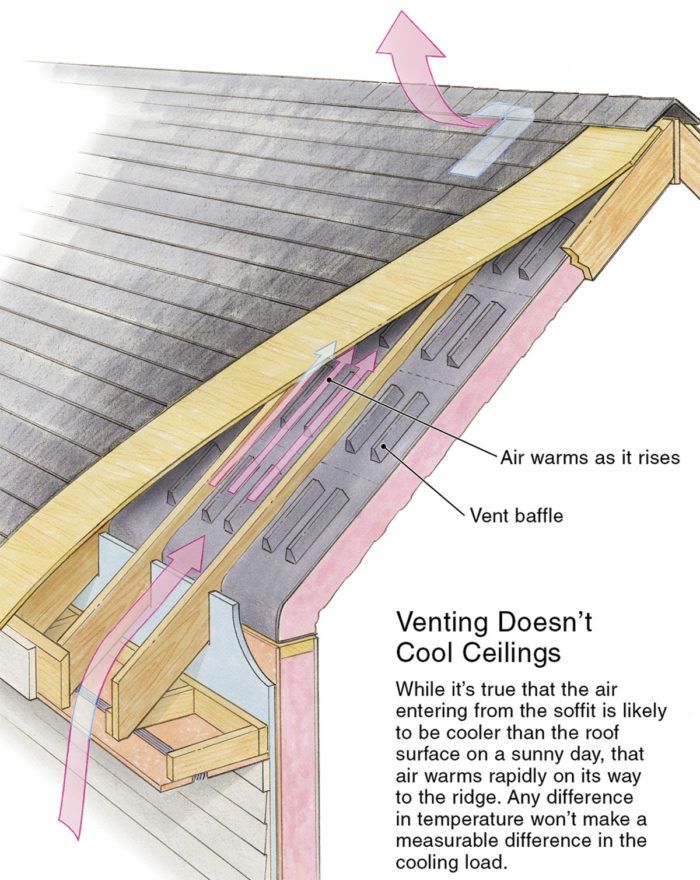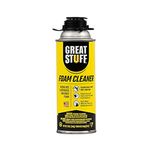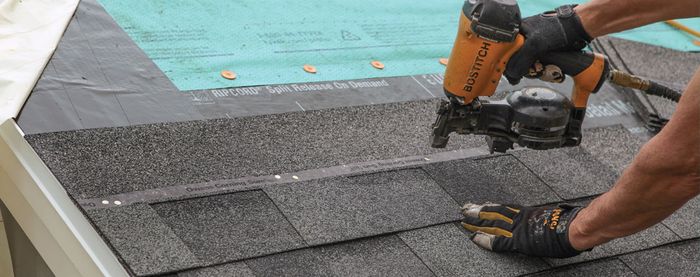Roof Venting Doesn’t Affect Cooling Loads
Can you measure cooling energy savings that might be attributed to the existence of a ventilation channel? Nope.

Q:
In Martin Holladay’s article, “How to Build an Insulated Cathedral Ceiling,” he says, “During the summer, roof ventilation does not significantly lower the temperature of asphalt shingles or other types of roofing.” This statement seems to indicate that there isn’t a shingle-temperature benefit to venting, but what about reducing cooling loads in the summer? A roof can easily reach 140°F during a sunny day. Suppose the cathedral ceilings are insulated with spray foam with no venting. That means the temperature gradient from one side of the insulation to the other is 70°F (140°F – 70°F). Heat will move through that insulation as a function of its R-value and the temperature difference. Now suppose we add soffit vents in order to displace the 140°F air on the back of the sheathing with the 90°F air from outside. Now we have just a 20°F temperature gradient (90°F – 70°F) across our insulated ceiling, which should reduce the cooling load. Of course, the actual air temperature in the vent channels will be higher than the outdoor air temperature, but you see my point. It should mean huge savings during cooling months, but I don’t see anyone discussing this benefit.
— Christopher Hansen, via email
A:
Martin Holladay: Several researchers, including William Rose and Jeff Gordon, have tried in vain to measure cooling energy savings that might be attributed to the existence of a ventilation channel. No researcher has ever succeeded in measuring such savings, because they don’t occur.
In a vented cathedral ceiling, the air entering the soffits is, as you guessed, at the outdoor air temperature. But by the time the air is one-third of the way up the roof, the temperature of the air in the ventilation channel is much higher than the outdoor air. The conclusion: Ventilation doesn’t result in significant cooling of the roofing or of the roof sheathing.
A ventilation channel won’t significantly change the temperature gradient across an insulated ceiling, either. Even if it did, you won’t have any significant energy savings if the roof assembly has code-minimum levels of insulation. (In most U.S. regions, building codes require a minimum of either R-38 or R-49.) Once you install that much insulation, the heat flow through the assembly is already quite small.
Fine Homebuilding Recommended Products
Fine Homebuilding receives a commission for items purchased through links on this site, including Amazon Associates and other affiliate advertising programs.

Peel & Stick Underlayment

Hook Blade Roofing Knife

Great Stuff Foam Cleaner






View Comments
How about if you have your roof covered in solar panels that have an air gap between them and the roof? They would be shading the roof, so you would think that they would help reduce the heat load inside the house. If so, such an effect would multiply the benefits of having solar panels on your roof!
OK, if the entering air is heated to above external ambient 1/3 of the way up the ventilation channel, it clearly is removing some heat, although maybe not much- the heat capacity of air is pretty low, so without significant flow, the cooling may be negligible. The good news is that in the winter, when the flow might be reversed, you don't lose much heat.
But that point quickly leads to a new question. If venting isn't removing heat, why ARE we doing it? The only other reason I can imagine is decreasing humidity. Can you comment, Martin?
And here I thought the idea that this kind of venting cooled roofs was based on building science. That means testing.
Has anyone actually tested the ability of this venting to produce a "cool roof" in the wintertime?
Has anyone actually tested weather this venting decreases moisture under roofing as BobboMax mentioned?
(Dr. Work, the shadow of the solar panels is preventing the sun's rays from hitting the shingles, so they would reduced the sun heat load by a lot. In cold climates, though, you would lose the heat gain on sunny days. Of course, this should be tested!)
Roofspaces are vented to limit condensation forming when the underside of the external roof cladding (or structure) is cooler than the air rising through the insulation from the occupied space below. Air drawn in from outside presumably has the capacity to remove this moisture and I agree that there will be times and climates where the benefits are questionable.
Ventilated roofspaces tend to be recommended (if not 'coded' - as they are in the UK in certain circumstances) for colder climates and the humidity passing through will be worse above uses like bathrooms. There's been lots of discussion about pros and cons over the years, but a small amount of air movement through the structure, on the external side, is no bad thing IMHO.
I believe that most of the heating that occures in the attic is secondary to radiation. The sun heats the roof surface, the building materials conduct the heat through the materials then the heat is reradiated inward. Convection of the air plays a minimal role. If it did, why would the roof get hot in the first place. It gets hot from solar radiation. The inside surfaces get hot from infared radiation. That is why reflective surfaces work so well to reduce heat transfer in the attic ( eg: reflective insulation around Ac ductwork). When it gets dirty it becomes a infared absorber. We all have an intuative sense that dark colors absorbes radiant energy and light colors reflect, just look at the outside world around you. I would bet that if you could take the roof off completely, during the day, the underside assembly would preform exactly the same way. What I mean is that air flow plays a minimal effect. Insulation is all that matters.
So they've attempted to prove there is usable cooling (reduced heat load on the conditioned space) and failed to demonstate it...
One wonders whether the shading/venting effect has been tested with significantly taller vented spaces? Perhaps 3 or 4+ inches, where there is freer air flow and a better chance of the entire cavity reaching outside ambient temperature.
I live in a warm climate (Tennessee) and was interested to know whether putting a radiant barrier (and possibly associated insulation) under the rafters in my existing attic would reduce heat gain in the attic? It is my understanding that radiant barriers work best if there is an airspace that allows the reflected hot air to escape. While I am not looking to encapsulate the attic anything to keep hot air out of the attic would reduce the cooling load in the house.
Thanks. Dan
Another non-conclusive one size fits all article that offers no solutions. Roof venting in the northeast was intended to keep ice at bay, with moderate success, again, depending on temperatures at any given point and time, as well as all the other variables (roof materials, insulation type, installation R-values, etc..). In the south and more moderate middle the issues are different. This I can tell you; in the south, whole house attic vents made a huge difference before AC. I'd suggest proper sizing, reflective barriers and even solar driven fans for air movement would indeed make a big difference in heat transmission.
One size fits all articles based on a couple of anecdotal "research" articles doesn't answer any questions or offer any solutions.